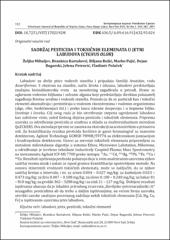Sadr┼Šaj pesticida i toksi─Źnih elemenata u jetri labudova

View/
Date
2018Author
Mihaljev, ┼Įeljko
Kartalovi─ć, Brankica
Bo┼Ši─ć, Biljana
Paji─ć, Marko
Bugarski, Dejan
Petrovi─ć, Jelena
Pola─Źek, Vladimir
Metadata
Show full item recordAbstract
Swans are wild birds living in water habitats and belong to the Anatidae family,
Anseriformes order. Considering their habitat, way of living and diet, swans represent
a significant bioindicator species for monitoring of environmental pollutants. Their
diet is composed of water plants and green algae which are direct indicators of
environmental and water habitat pollution. It is known that pesticides as well as
toic elements accumulate and persist in water ecosystems and water organisms
(algae, fish, invertebrates, etc.) and reach embriophyte, animals and humans through
the food chain. The aim of this paper is to determine the etent to which swans are
endangered, as a protected species, due to harmful effects of pesticides and toic
elements. The sample preparation for determining pesticides has been conducted
in accordance with the Multiresidue Method QuEChERS. This preparation method is
based on the etraction with acetonitrile in the presence of salt. Gas chromatography
with mass spectometry has been used for uantification of pesticide residues. Agilent
Technology GCMSD 7890B/5977A with electron ionization and uadrupole mass
spectometer. The samples for toic element measurement have been prepared using
the method of microwave digestion in the system Ethos, Microwave Labstation,
Milestone and determination has been conducted using the Inductively Coupled
Plasma Mass Spectrometry techniue on the Agilent ICP-MS 7700 instrument through
isotopes: 75As, 111Cd, 201Hg, 208Pb, 56Fe, 63Cu and 66Zn. Pesticide eamination
results show their low content in all analysed samples, below uantification limit
of the used method. According to the measured values of toic elements, it can be
concluded that their content range was the following: for arsen 0.004-0.027 mg/kg for
cadmium 0.023-0.473 mg/kg for mercury 0.007-0.188 mg/kg for lead 0.108 -0.248
mg/kg for copper 81-810 mg/kg for iron 362-3288 mg/kg and for zinc 21 -127 mg/
kg. The obtained eamination results indicate the absence of pesticide pollution at the
locality of the natural reserve „Koviljsko-petrovaradinski rit“. However, the causes of significantly higher content of toic elements (Cd, Hg, Cu, Fe) in the eamined samples
in the swans liver should be further eamined on a larger number of samples.
